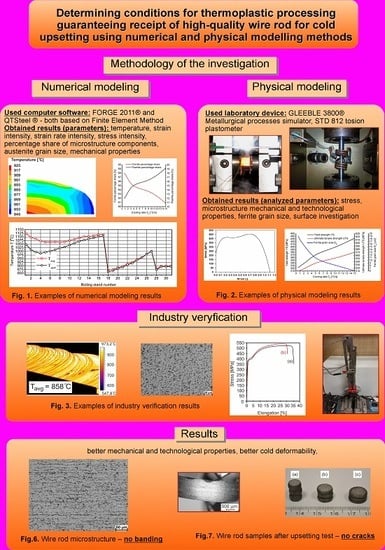Determining Conditions for Thermoplastic Processing Guaranteeing Receipt of High-Quality Wire Rod for Cold Upsetting Using Numerical and Physical Modelling Methods
Abstract
:1. Introduction
2. Materials and Methods
2.1. Materials
2.2. Process Characteristics
2.3. Numerical Modelling
2.3.1. Mathematical Model of FORGE 2011® Program
2.3.2. Initial and Boundary Conditions of Wire Rod Rolling Process
2.3.3. Rheological Properties of 20MnB4 Steel
2.3.4. Mathematical Model of QTSteel Program®
2.4. Physical Modelling
3. Results
3.1. Numerical Modelling Results
3.2. Physical Modelling Results
3.3. Industrial Verification of Numerical and Physical Modelling of Wire Rod Rolling Process
4. Discussion
- -
- the best cooling variant is the W1-5 variant, in which the cooling rate was 10 °C/s—such parameters of thermoplastic processing ensure that a final product with a favourable complex of mechanical and technological properties as well as a fine-grained, even microstructure, lacking clear banding is obtained,
- -
- the wire rod produced in this way has a high yield strength of 0.74 and can be cold deformed with a relative plastic strain of 75%, without compromising the consistency of the material,
- -
- cooling of the examined steel grade after rolling in the RSM block at the temperature of 850 °C and subsequent controlled cooling in the range of 0.6–15°C/s ensures that a ferritic–pearlitic microstructure in the wire rod is obtained,
- -
- in the examined range, an increase in the cooling rate causes an increase in the analysed mechanical and technological properties of wire rods from 20MnB4 steel,
- -
- in the studied cooling rate range, an increase in the cooling rate caused a simultaneous increase in the yield strength, tensile strength and yield strength of the investigated steel,
- -
- the results obtained during the industrial verification correspond with high accuracy to the results obtained from the numerical and physical modelling of the analysed rolling mill process. This confirms the correct definition of the initial and boundary conditions during numerical modelling, especially the rheological properties of the tested steel, friction conditions and heat transfer coefficients.
Author Contributions
Funding
Conflicts of Interest
References
- Lundberg, S.E. A vision of wire rod rolling technology for the twenty first century. Adv. Mater. Res. 2007, 23, 39–44. [Google Scholar] [CrossRef]
- Grosman, F.; Woźniak, D. Nowoczesne walcownie walcówki (Modern wire rod rolling mills). Hutnik-Wiadomości Hutnicze 2001, 3, 97–104. [Google Scholar]
- Laber, K. Nowe Aspekty Wytwarzania Walcówki Ze Stali Do Sspęczania Na Zimno (New Aspects of Wire Rod Production from Steel for Cold Heading); Seria: Monografie nr 79 (Series: Monograph No. 79); Czestochowa University of Technology, Faculty of Production Engineering and Materials Technology Publishing House: Częstochowa, Poland, 2018; ISBN 978-83-63989-64-4. ISSN 2391-632X. [Google Scholar]
- Garstka, T.; Dyja, H.; Laber, K.; Koczurkiewicz, B. Experimental study of the power parameters in rolling process of high carbon steel wire rod. Obrabotka Materialov Davleniem 2015, 3, 246–251. [Google Scholar]
- Grosman, F.; Woźniak, D. Technologiczne aspekty walcowania walcówki z nowoczesnych stali (Technological aspects of wire rod rolling of modern steel). Hutnik-Wiadomości Hutnicze 2002, 11, 408–414. [Google Scholar]
- Kazeminezhad, M.; Karimi Taheri, A. The effect of controlled cooling after hot rolling on the mechanical, properties of a commercial high carbon steel wire rod. Mater. Des. 2003, 24, 415–421. [Google Scholar] [CrossRef]
- Knapiński, M.; Koczurkiewicz, B.; Dyja, H.; Kawałek, A.; Laber, K. The analysis of influence production conditions on properties C70D 5,5 mm diameter wire rod. In Proceedings of the 23rd International Conference on Metallurgy and Materials—METAL 2014, Brno, Czech Republic, 21–23 May 2014. [Google Scholar]
- Koczurkiewicz, B.; Dyja, H.; Niewielski, G. The influence of cooling conditions on perlite morphology of high carbon wire rods. In Proceedings of the 24th International Conference on Metallurgy and Materials—METAL 2015, Brno, Czech Republic, 3–5 June 2015; pp. 699–703. [Google Scholar]
- Kuc, D.; Szala, J.; Bednarczyk, I. Wpływ temperatury walcowania na właściwości i mikrostrukturę stali C70D przeznaczonej na walcówkę (Influence of rolling temperature on the properties and microstructure of C70D steel designed for wire rod). Hutnik-Wiadomości Hutnicze 2016, 8, 348–350. [Google Scholar] [CrossRef]
- Laber, K.; Dyja, H.; Koczurkiewicz, B. Analysis of the industrial conditions of the multi-stage cooling process of the 5.5 mm in diameter wire rod of C70D high-carbon steel. Mater. Test. 2015, 57, 301–305. [Google Scholar] [CrossRef]
- Laber, K.; Dyja, H.; Koczurkiewicz, B.; Garstka, T. Vlijanie rezhimov termomekhanicheskoj obrabotki na mikrostrukturu i svojstva katanki diametrom 5,5 mm iz stali marki C70D (Influence of thermoplastic processing conditions on microstructure and properties of 5.5 mm diameter wire rod made of C70D steel grade). Obrabotka Materialov Davleniem 2015, 2, 252–258. [Google Scholar]
- Majta, J.; Łuksza, J.; Bator, A.; Szynal, H. Walcówka ze stali z mikrododatkami stopowymi do dalszego przerobu plastycznego na zimno (Microalloyed steel wire rod for subsequent cold forming). Hutnik-Wiadomości Hutnicze 2003, 3, 95–103. [Google Scholar]
- Niewielski, G.; Kuc, D.; Hadasik, E.; Bednarczyk, I. Influence of hot working and cooling conditions on the microstructure and properties of C70D steel for wire rod. In Proceedings of the 26th International Conference on Metallurgy and Materials—METAL 2017, Brno, Czech Republic, 24–26 May 2017; pp. 490–495. [Google Scholar]
- Koczurkiewicz, B.; Dyja, H.; Kawałek, A.; Stefanik, A. Modeling of Microstructure Changes of C70D Wire Rod. In Sovremennye Metody i Tekhnologii Sozdanija i Obrabotki Materialov (Modern Methods and ProductionTechnologies and Materials Processing); Fiziko-Techniceskij Institut Nacional’noj Akademii Nauk Belarusi (Physical and Technical Institute of the National Academy of Sciences of Belarus): Minsk, Ukraine, 2016; pp. 76–82. [Google Scholar]
- Koczurkiewicz, B.; Stefanik, A.; Laber, K. The model of austenite microstructure of high-carbon steel. In Proceedings of the 25th Anniversary International Conference on Metallurgy and Materials—METAL 2016, Brno, Czech Republic, 25–27 May 2016. [Google Scholar]
- Fang, C.-J.; Lin, Y.Y. A novel temperature diagnostic system for Stelmor air-cooling of wire rods. China Steel Tech. Rep. 2012, 25, 66–72. [Google Scholar]
- Lambert, N.; Wilmotte, S.; Economopoulos, M. Improving the Properties of Wire by Suppressing the Recalescence on a Stelmor Conveyor; Technical Steel Research. Mechanical Working, Contract No. 7210.EA/2/205; Commission of the European Communities: Brussels, Luxembourg, 1983.
- Lindemann, A.; Schmidt, J. ACMOD-2D—A heat transfer model for the simulation of the cooling of wire rod. J. Mater. Process. Technol. 2005, 169, 466–475. [Google Scholar] [CrossRef]
- Morales, R.D.; Lopéz, A.G.; Olivares, I.M. Mathematical simulation of Stelmor process. Ironmak. Steelmak. 1991, 18, 128–138. [Google Scholar]
- Viéitez, I.; López-Cancelos, R.; Martín, E.B.; Varas, F. Predictive model of wire rod cooling. In Proceedings of the 28th ASM Heat Treating Society Conference, Detroit, MI, USA, 20–22 October 2015; pp. 518–524. [Google Scholar]
- Vincent, J.C.; Kiefer, B.V. Modernization of Stelmor conveyor systems for expanded process capability and improved product quality. Wire J. Int. 2004, 37, 158–161. [Google Scholar]
- Yu, W.-H.; Chen, S.-H.; Kuang, Y.-H.; Cao, K.-C. Development and application of online Stelmor controlled cooling system. Appl. Therm. Eng. 2009, 29, 2949–2953. [Google Scholar] [CrossRef]
- Lee, Y.; Choi, S.; Hodgson, P.D. Integrated model for thermomechanical controlled process in rod or bar rolling. J. Mater. Process. Technol. 2002, 125–126, 678–688. [Google Scholar] [CrossRef]
- Shida, S. Empirical formula of flow stress of carbon steels—Resistance to deformation of carbon steels at elevated temperature. J. JSTP 1969, 10, 610–617. [Google Scholar]
- Johnson, G.R.; Cook, W.H. A constitutive model and data for metals subjected to large strains, high strain rates and high temperatures. In Proceedings of the Seventh International Symposium on Ballistic, The Hague, The Netherlands, 19–21 April 1983. [Google Scholar]
- Majta, J.; Stefańska-Kądziela, M.; Muszka, K.; Bator, A. High strain rate behavior of microalloyed steels for automotive applications. In Proceedings of the 8th International Conference on Technology of Plasticity—Advanced Technology of Plasticity 2005, Verona, Italy, 9–13 October 2005; p. 432. [Google Scholar]
- Stefańska-Kądziela, M. Odkształcanie Plastyczne W Warunkach Dynamicznego Obciążenia (Plastic Deformation under Dynamic Loading Conditions). Ph.D. Thesis, AGH, Kraków, Poland, 2006. [Google Scholar]
- Stefańska-Kądziela, M. Wpływ prędkości odkształcenia na naprężenie uplastyczniające stali mikrostopowych (Influence of strain rate on the flow stress of microalloyed steels). Hutnik Wiadomości Hutnicze 2006, 11, 500–505. [Google Scholar]
- Stefańska-Kądziela, M.; Majta, J.; Muszka, K. Wpływ prędkości odkształcenia na umocnienie stali niskowęglowych i mikrostopowych (Influence of strain rate on the low carbon and microalloyed steels hardening). Prace Naukowe—Mechanika 2005, 207, 19. [Google Scholar]
- Zerilli, F.J.; Armstrong, R.W. Dislocation-mechanics-based constitutive relations for material dynamics calculations. J. Appl. Phys. 1987, 61, 1816. [Google Scholar] [CrossRef] [Green Version]
- Gorbanev, A.A.; Zhuchkov, S.M.; Filippov, V.V.; Timoshpolskij, V.I.; Steblov, A.B.; Junakov, A.M.; Tishhenko, V.A. Teoreticheskie I Tekhnologicheskie Osnovy Vysokoskorostnoj Prokatki Katanki (Theoretical and Technological Basis of High Speed Wire Rod Production); Izdatelstvo Vyshehjshaja Shkola (College Publishing House): Minsk, Ukraine, 2003. [Google Scholar]
- Timoshpolskij, V.I.; Andrianov, N.V.; Zhuchkov, S.M.; Matochkin, V.A.; Tisshenko, V.A.; Mandel, N.L.; Gorbanev, A.A. Proizvodstvo Vysokouglerodistoj Katanki Na Matalurgicheskikh Agregatakh Vysshego Tekhnicheskogo Urovnja (Production of High-Carbon Wire Rod on High-Tech Devices); Belaruskaja Navuka (Belarusian Science): Minsk, Ukraine, 2004. [Google Scholar]
- Kuc, D.; Niewielski, G.; Bednarczyk, I.; Schindler, I. Wpływ temperatury walcowania i warunków chłodzenia na właściwości i mikrostrukturę stali 23MnB4 przeznaczonej do spęczania na zimno (Influence of rolling temperature and cooling conditions on 23MnB4 steel properties and microstructure designed for cold upsetting). Hutnik-Wiadomości Hutnicze 2016, 9, 413–416. [Google Scholar] [CrossRef]
- Kuc, D.; Niewielski, G.; Schindler, I.; Bednarczyk, I. Influence of rolling temperature and cooling conditions on the properties and microstructure of steel 23MnB4 for cold-heading. In Proceedings of the 25th Anniversary International Conference on Metallurgy and Materials—METAL 2016, Brno, Czech Republic, 25–27 May 2016; pp. 452–457. [Google Scholar]
- Kuc, D.; Szala, J.; Bednarczyk, I. Quantitative evaluation of the microstructure and mechanical properties of hot rolled 23MnB4 steel grade for cold upsetting. Arch. Metall. Mater. 2017, 62, 551–556. [Google Scholar] [CrossRef] [Green Version]
- Polska Norma PN-EN 10263-4:2004. Stal-Walcówka, pręty i drut do spęczania i wyciskania na zimno. Część 4: Warunki techniczne dostawy stali do ulepszania cieplnego (Steel—Wire rRod, Bars and Wire for Cold Upsetting and Extrusion. Part 4: Technical Delivery Conditions for Steel for Quenching and Tempering); Polski Komitet Normalizacyjny (Polish Committee for Standardization): Warszawa, Poland, 2004. [Google Scholar]
- Polska Norma PN-83/H-04411. Próba Spęczania Metali (Metals Upsetting Test); Polski Komitet Normalizacji, Miar i Jakości, Wydawnictwa Normalizacyjne Alfa (Polish Committee for Standardization, Measurement and Quality, Alfa Publishing House): Warszawa, Poland, 1983. [Google Scholar]
- Okonogi, M.; Yamazaki, K. Development of medium carbon steel wire rods for cold heading by isothermal transformation treatment. Nippon Steel Sumitomo Metal Tech. Rep. 2017, 116, 65–70. [Google Scholar]
- Tsuchida, K.; Shinbo, Y. Special steel wire rods for cold forging with high property. Nippon Steel Tech. Rep. 2007, 96, 29–33. [Google Scholar]
- Dobrzański, L.A. Metaloznawstwo Z Podstawami Nauki O Materiałach (Metal Science with the Basics of Materials Science); Wydawnictwa Naukowo-Techniczne (Scientific and Technical Publishers): Warszawa, Poland, 1996. [Google Scholar]
- Polska Norma PN-EN 10025. Wyroby Walcowane Na Gorąco Z Niestopowych Stali Konstrukcyjnych. Warunki Techniczne Dostawy (Hot Rrolled Products of Non-Alloy Constructional Steels. Technical Conditions of Delivery); Polski Komitet Normalizacyjny (Polish Committee for Standardization): Warszawa, Poland, 2002. [Google Scholar]
- Paduch, J.; Szulc, W. (Eds.) Kształtowanie nowych jakości oraz racjonalizacja kosztów wytwarzania wyrobów stalowych dostosowanych do wymagań konkurencyjnych rynku. cz. 3: Dostosowanie technologii hutniczych do aplikacyjnych i jakościowych potrzeb rynku (Shaping New Qualities and Rationalizing of the Steel Products Production Costs Adapted to the Market’s Competitive Requirements. Part. 3: Adaptation of Metallurgical Technologies to the Application and Quality Needs of the Market); Works of the Iron Metallurgy Institute: Gliwice, Poland, 2000; Volume 52, pp. 17, 19, 24–25. [Google Scholar]
- Kajzer, S.; Kozik, R.; Wusatowski, R. Walcowanie Wyrobów Długich. Technologie Walcownicze; Wyd. Politechniki Śląskiej: Gliwice, Poland, 2004. [Google Scholar]
- Hoff, N.J. Approximate analysis of structures in the presence of moderately large steps deformation. Q. Appl. Mech. 1954, 2, 49. [Google Scholar] [CrossRef] [Green Version]
- Norton, F.H. Creep of Steel at High Temperature; McGraw Hill: New York, NY, USA, 1929. [Google Scholar]
- Mróz, S. Teoretyczno-Technologiczne Podstawy Walcowania Prętów Bimetalowych W Wykrojach (Theoretical and Technological Basics of Rolling Bimetallic Bars in Grooves); Wydawnictwo Wydziału Inżynierii Produkcji i Technologii Materiałów Politechniki Częstochowskiej (Czestochowa University of Technology, Faculty of Production Engineering and Materials Technology Publishing House): Częstochowa, Poland, 2015. [Google Scholar]
- Minaev, A.A. Sovmeshhennye Matallurgicheckie Procesy (Modern Metallurgical Processes); Vidavnictvo (Publishing House) TOV Tekhnopark DonNTU Unitekh: Doneck, Ukraine, 2008. [Google Scholar]
- Minaev, A.A.; Ustimenko, S.V. Kontrolirujemaja Prokatka Sortovoj Stali (Controlled Plastic Working of Steel Long Products); Izdatelstvo Metallurgija (Metallurgy Publishing House): Moskva, Russia, 1990. [Google Scholar]
- Mróz, S. Modelowanie walcowania prętów żebrowanych otrzymanych mteodą wzdłużnego rozdzielania pasma (Modeling of rolling of ribbed bars obtained by the method of longitudinal band separation). Prace Naukowe—Mechanika 2005, 207, 66. [Google Scholar]
- Noguchi, Y.; Okamura, K.; Tanabe, K.; Ogai, H.; Hizume, T.; Yoshimura, K. Characteristic of continuous wire rod rolling and precision rolling system. Nippon Steel Tech. Rep. 1999, 80, 79–83. [Google Scholar]
- Pietrzyk, M. Metody Numeryczne W Przeróbce Plastycznej Metali (Numerical Methods in Metal Forming); Wydawnictwa Akademii Górniczo-Hutniczej (University of Science and Technology Publishing Houses): Kraków, Poland, 1992. [Google Scholar]
- Šimeček, P.; Hajduk, D. Prediction of mechanical properties of hot rolled steel products. J. Achiev. Mater. Manuf. Eng. 2007, 20, 395–398. [Google Scholar]
- Šimeček, P.; Turoň, R.; Hajduk, D. Computer model for prediction of mechanical properties of long products after heat treatment. In Proceedings of the 68th ABM International Annual Congress, Belo Horizonte Minas Gerais, Brazil, 30 July–2 August 2013. [Google Scholar]
- Dyja, H.; Krakowiak, M. Kronika 60-Lecia—Od Wydziału Metalurgicznego do Wydziału Inżynierii Procesowej, Materiałowej i Fizyki Stosowanej (The 60th Anniversary Chronicle—from the Faculty of Metallurgy to the Faculty of Process, Materials Engineering and Applied Physics); Wydawnictwo Wydziału Inżynierii Procesowej, Materiałowej i Fizyki Stosowanej Politechniki Częstochowskiej (Czestochowa University of Technology, Faculty of Process, Materials Engineering and Applied Physics Publishing House): Częstochowa, Poland, 2010. [Google Scholar]
- Laber, K.; Koczurkiewicz, B. Determination of optimum conditions for the process of controlled cooling of rolled products with diameter 16.5 mm made of 20MnB4 steel. In Proceedings of the 24th International Conference on Metallurgy and Materials—METAL 2015, Brno, Czech Republic, 3–5 June 2015; pp. 364–370. [Google Scholar]
- Laber, K. Problemy fizycznego modelowania procesów walcowania walcówki z dużymi prędkościami (The problems of physical modelling of the processes of wire rod rolling at high rolling velocities). Obróbka Plastyczna Metali (Metal Forming). 2016, 27, 119–132. [Google Scholar]
- Laber, K. Wpływ historii odkształcenia, stanu odkształcenia oraz prędkości odkształcenia na naprężenie uplastyczniające, mikrostrukturę i własności mechaniczne stali 30MnB4 podczas fizycznego modelowania procesu walcowania prętów (Influence of the strain history, strain state and strain rate on the flow stress, microstructure and mechanical properties of the 30MnB4 steel grade during physical modeling of the bar rolling process). Hutnik-Wiadomości Hutnicze 2016, 83, 232–237. [Google Scholar] [CrossRef]
- Laber, K.; Dyja, H.; Koczurkiewicz, B.; Sawicki, S. Fizyczne modelowanie procesu walcowania walcówki ze stali 20MnB4 (Physical modeling of the wire rod rolling process of 20MnB4 steel). In Proceedings of the VI Konferencja Naukowa WALCOWNICTWO 2014. Procesy-Narzędzia-Materiały (VI Scientific Conference Rolling Mill Practice 2014. Processes-Tools-Materials), Ustroń, Poland, 20–22 October 2014; pp. 37–42. [Google Scholar]
- Laber, K.B.; Savickij, S.Z.; Dyja, H.S.; Kavalek, A.M. Sravnitelnyj analiz rezultatov fizicheskogo modelirovanija processa prokatki prutkov iż stali 30MnB4 pri ispytanii na kruchenie i ispytanii na szhatie (Physical modelling of 30MnB4 steel rod production during torsion and compression testing: Comparative analysis). Vestnik Magnitogorskogo Gosudarstvennogo Tekhnicheskogo Universiteta 2016, 14, 32–37. [Google Scholar] [CrossRef]
- Hodgson, P.D.; Gibbs, R.K. A mathematical model to predict the mechanical properties of hot rolled C-Mn and microalloyed steels. ISIJ Int. 1992, 32, 1329–1338. [Google Scholar] [CrossRef] [Green Version]
- Metale—Próba Rozciągania—Część 1: Metoda Badania w Temperaturze Pokojowej (Metals—Tensile testing—Part 1: Test Method at Room Temperature); PN-EN ISO 6892-1:2016-09; Polski Komitet Normalizacyjny (Polish Committee for Standardization): Warszawa, Poland, 2016.
- Knap, F.; Kruzel, R.; Cieślak, Ł. Ciągnienie Drutów, Prętów I Rur (Drawing of Wires, Rods and Pipes); Wydawnictwo Wydziału Inżynierii Procesowej, Materiałowej i Fizyki Stosowanej Politechniki Częstochowskiej (Czestochowa University of Technology, Faculty of Process, Materials Engineering and Applied Physics Publishing House): Częstochowa, Poland, 2004. [Google Scholar]
- Próba Spęczania Metali (Upsetting test of metals); PN-83/H-04411. Polski Komitet Normalizacji, Miar i Jakości (Polish Committee for Standardization, Measures and Quality); Wydawnictwa Normalizacyjne (Standardization Publishers) Alfa: Warszawa, Poland, 1983. [Google Scholar]
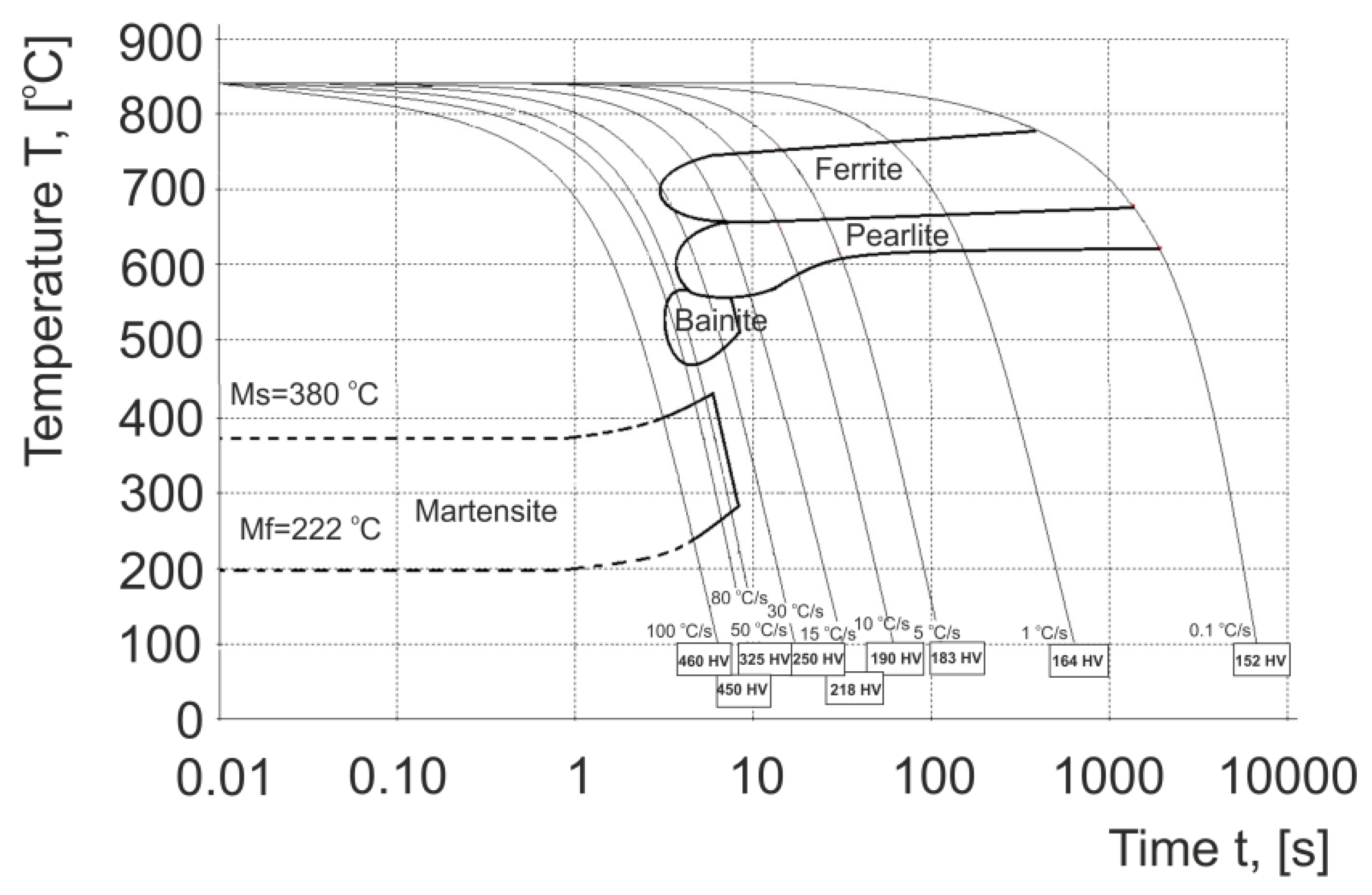
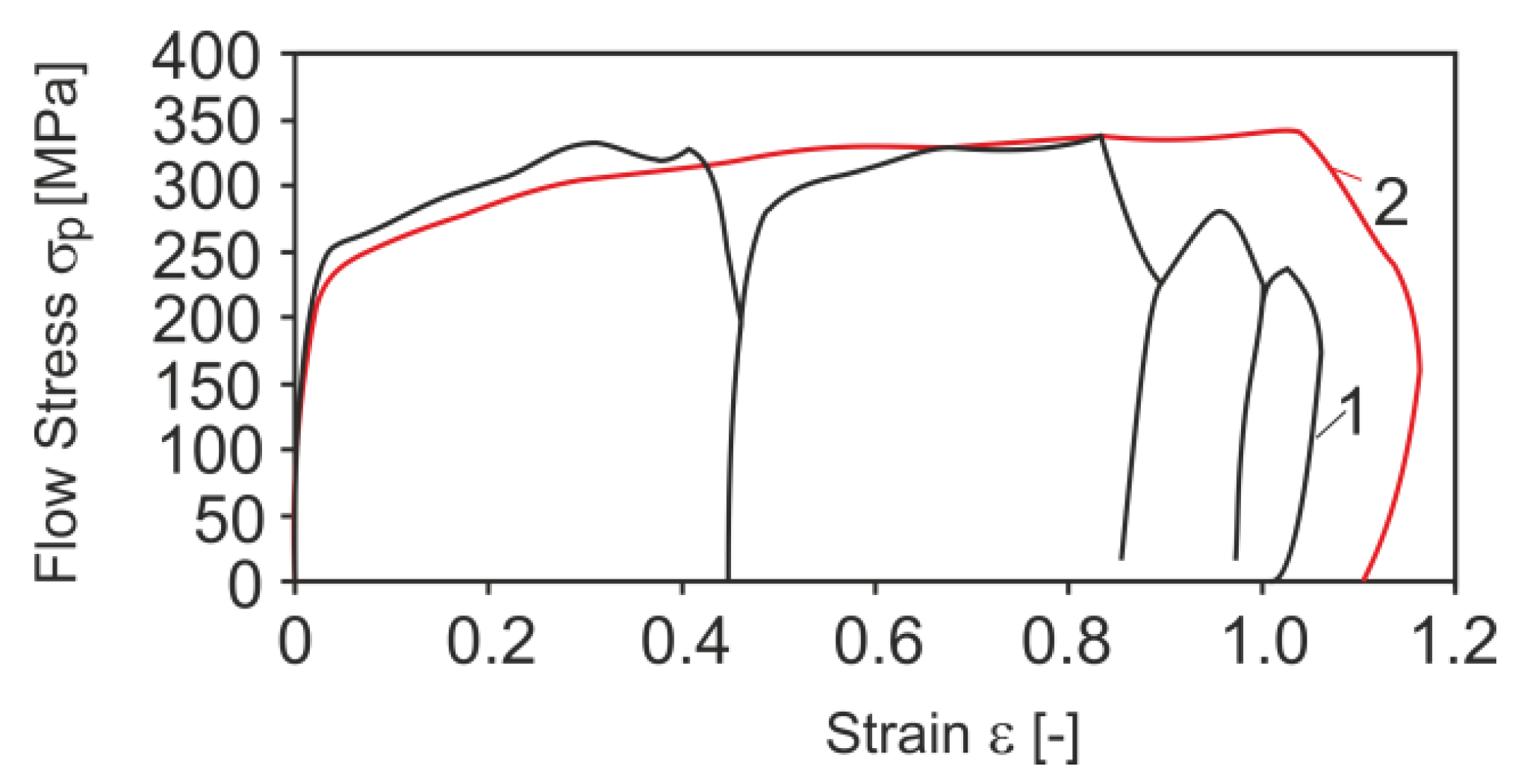

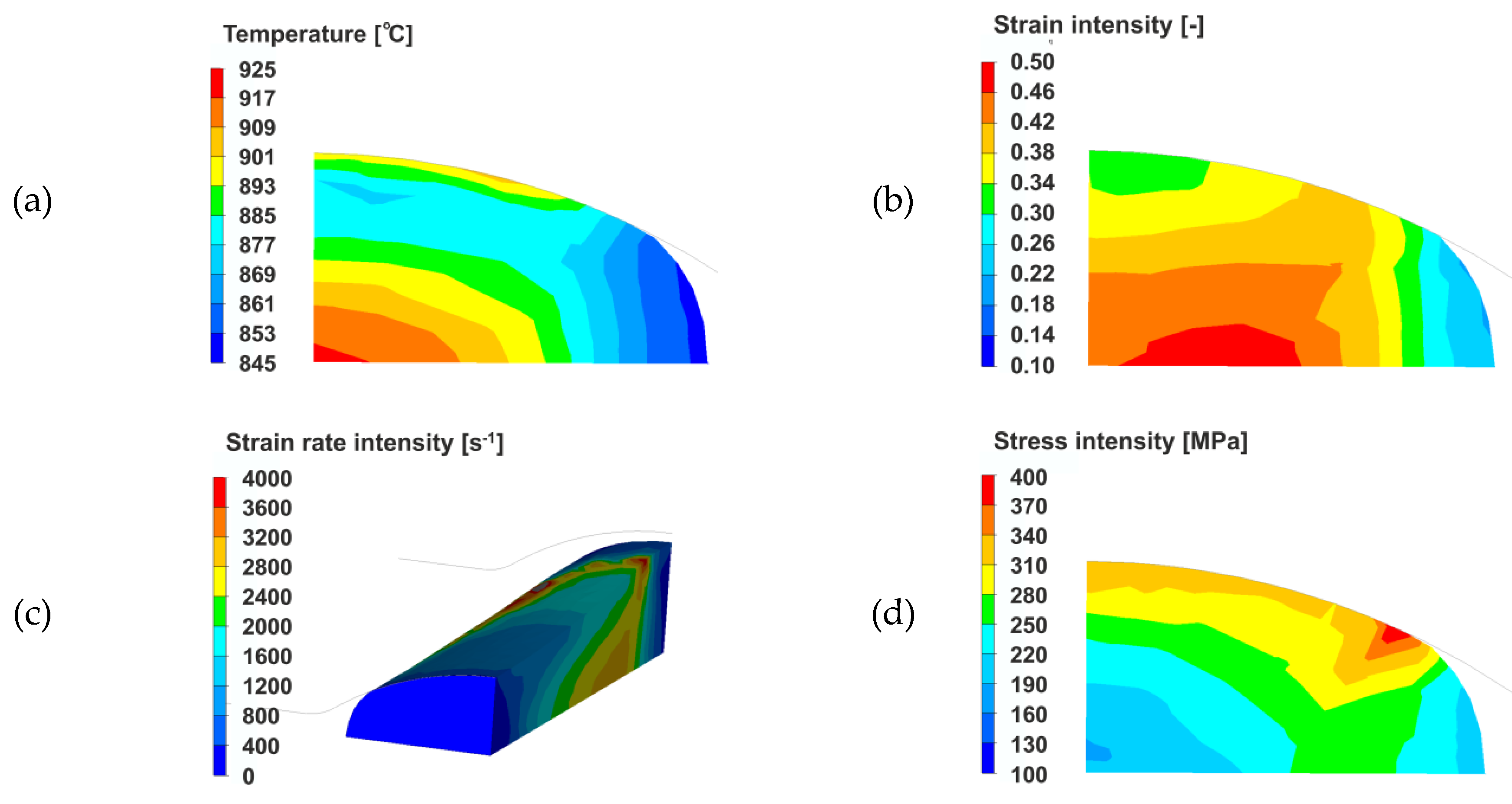

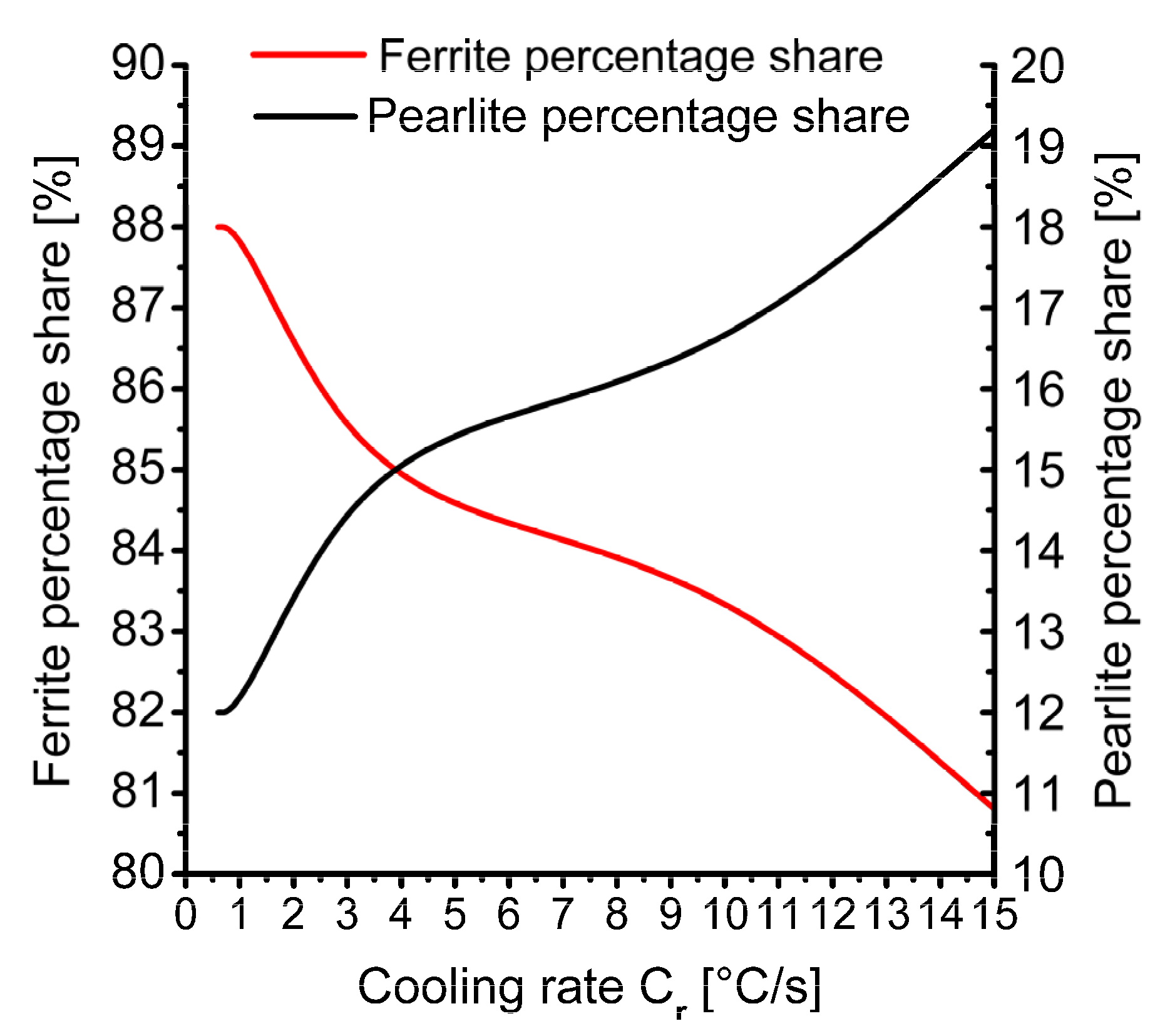


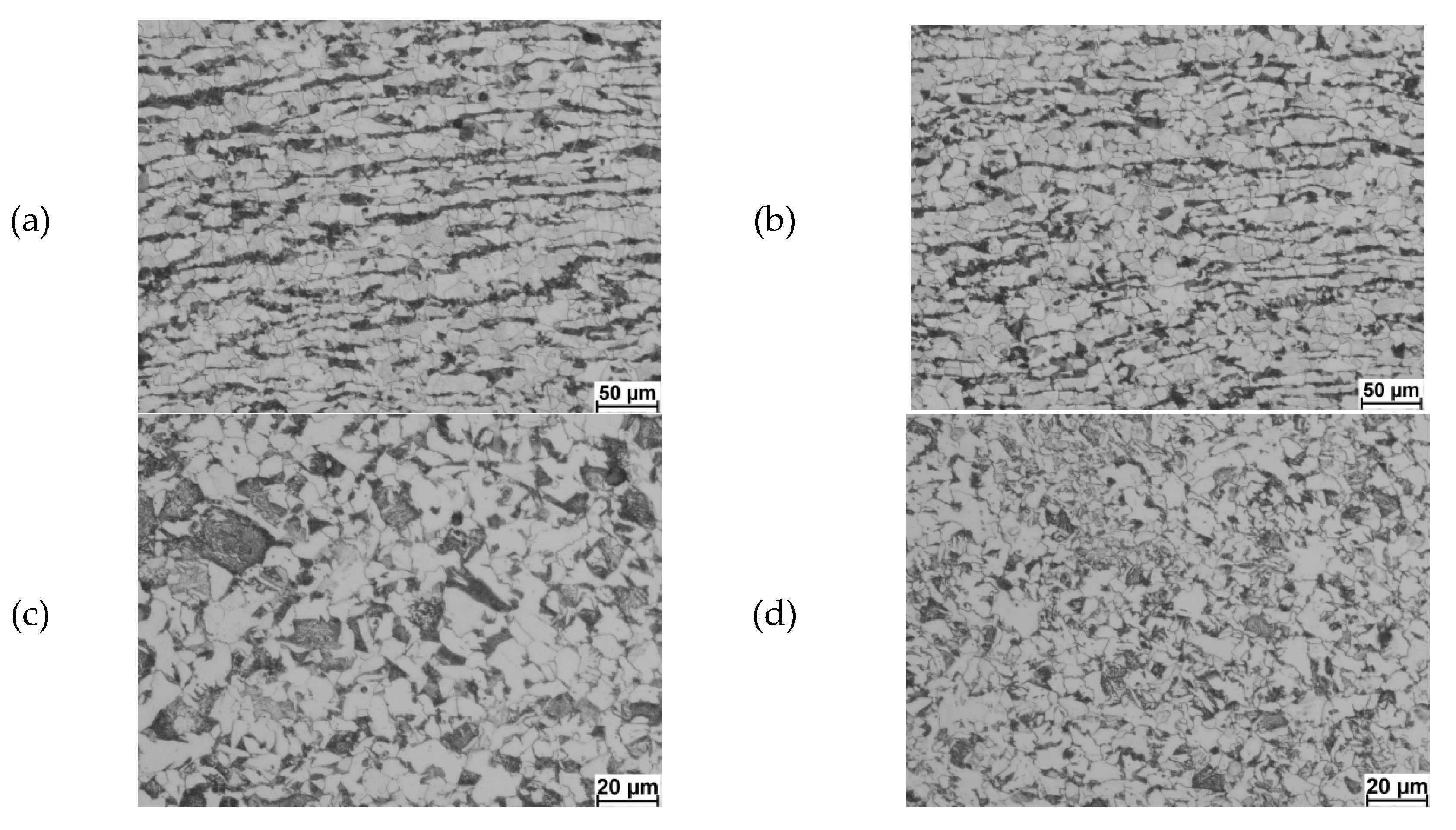
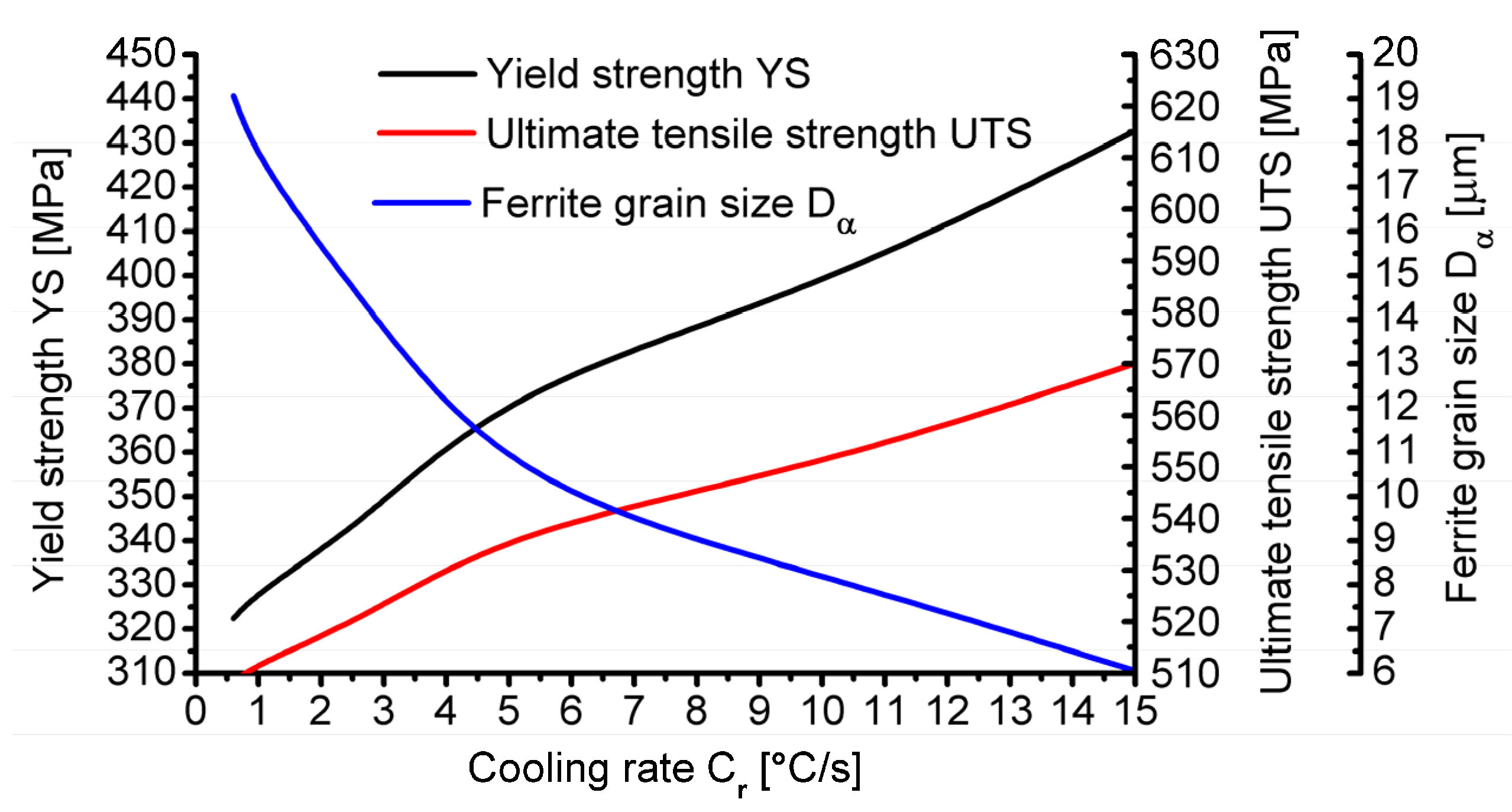

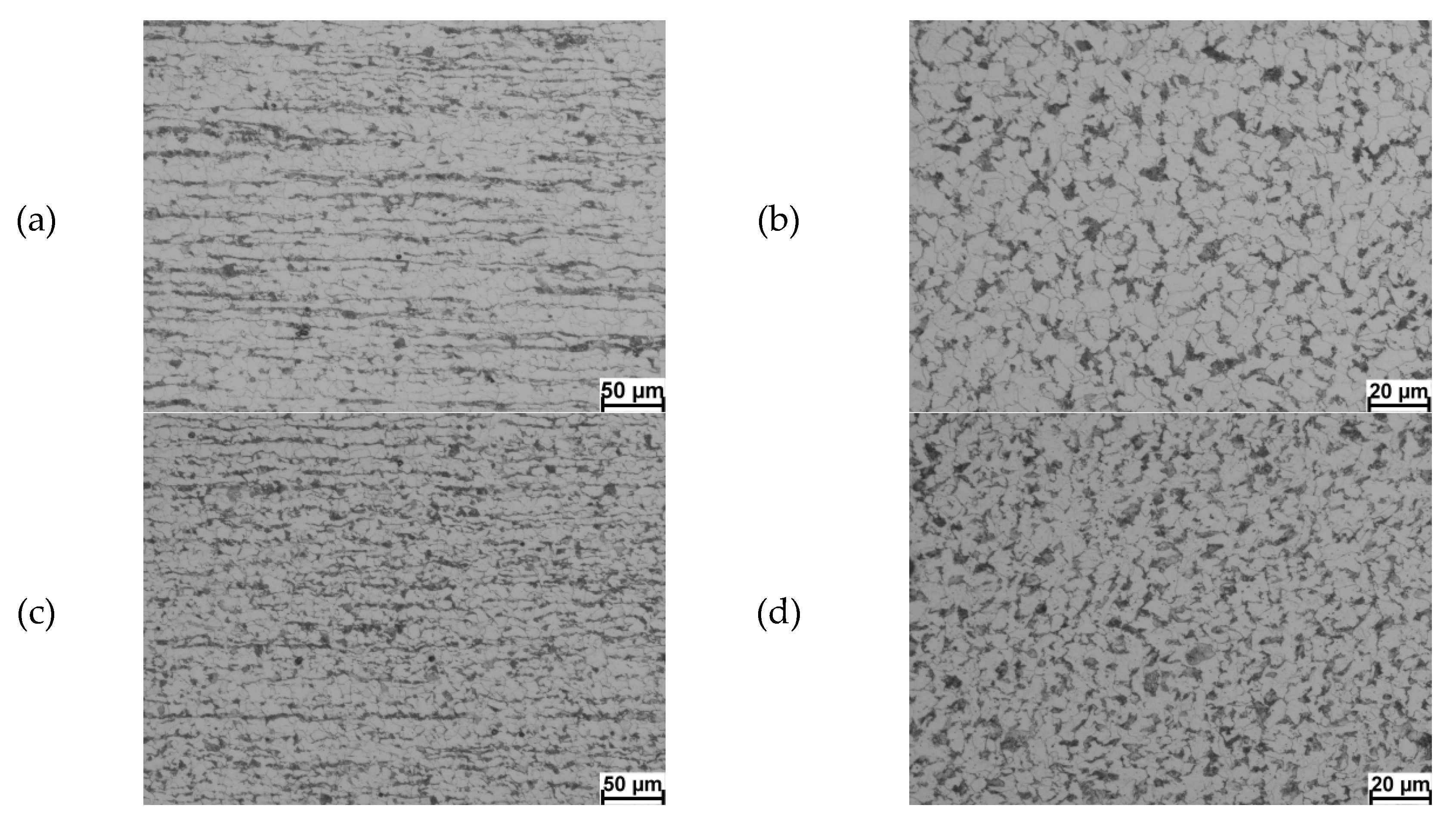
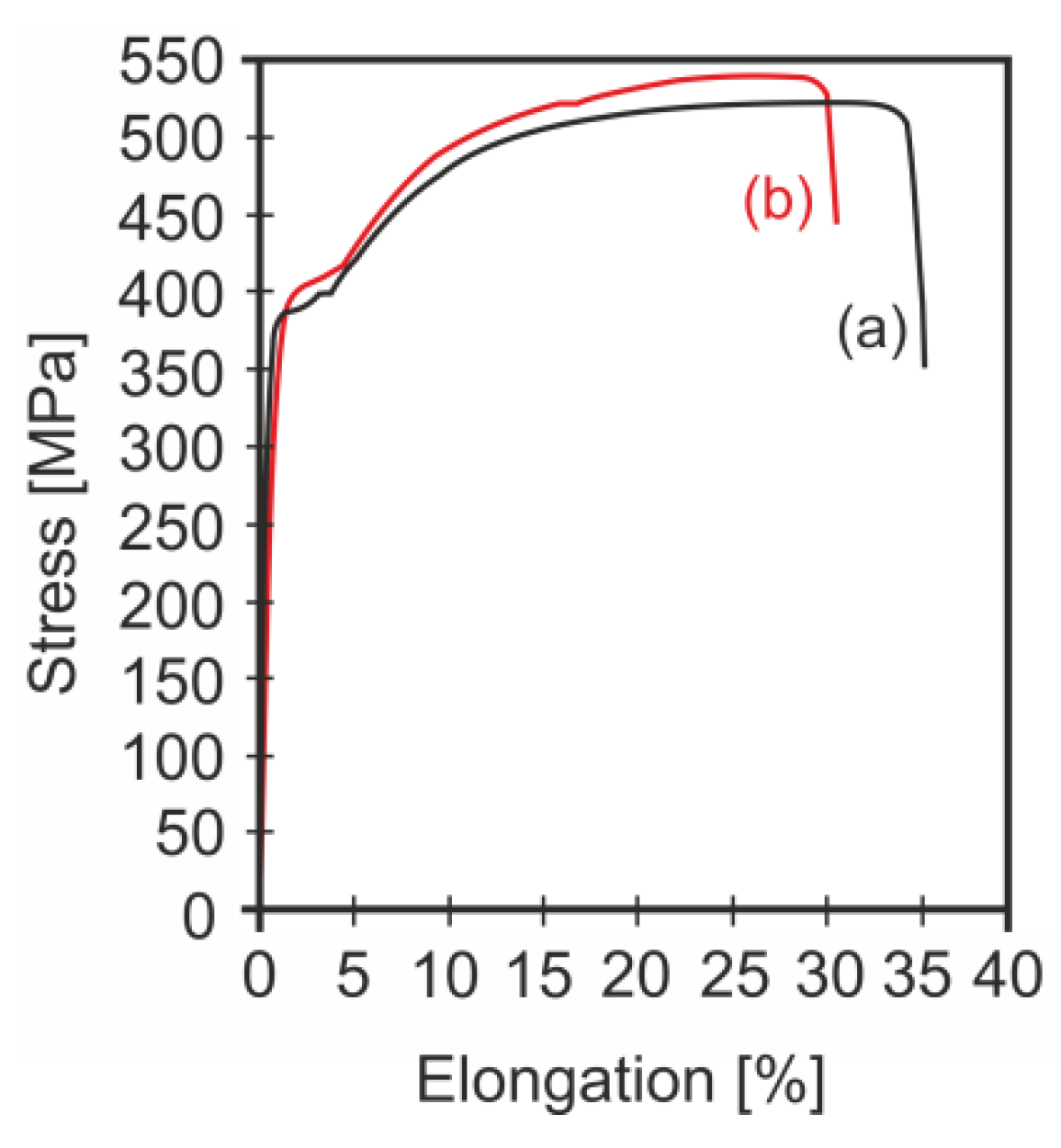
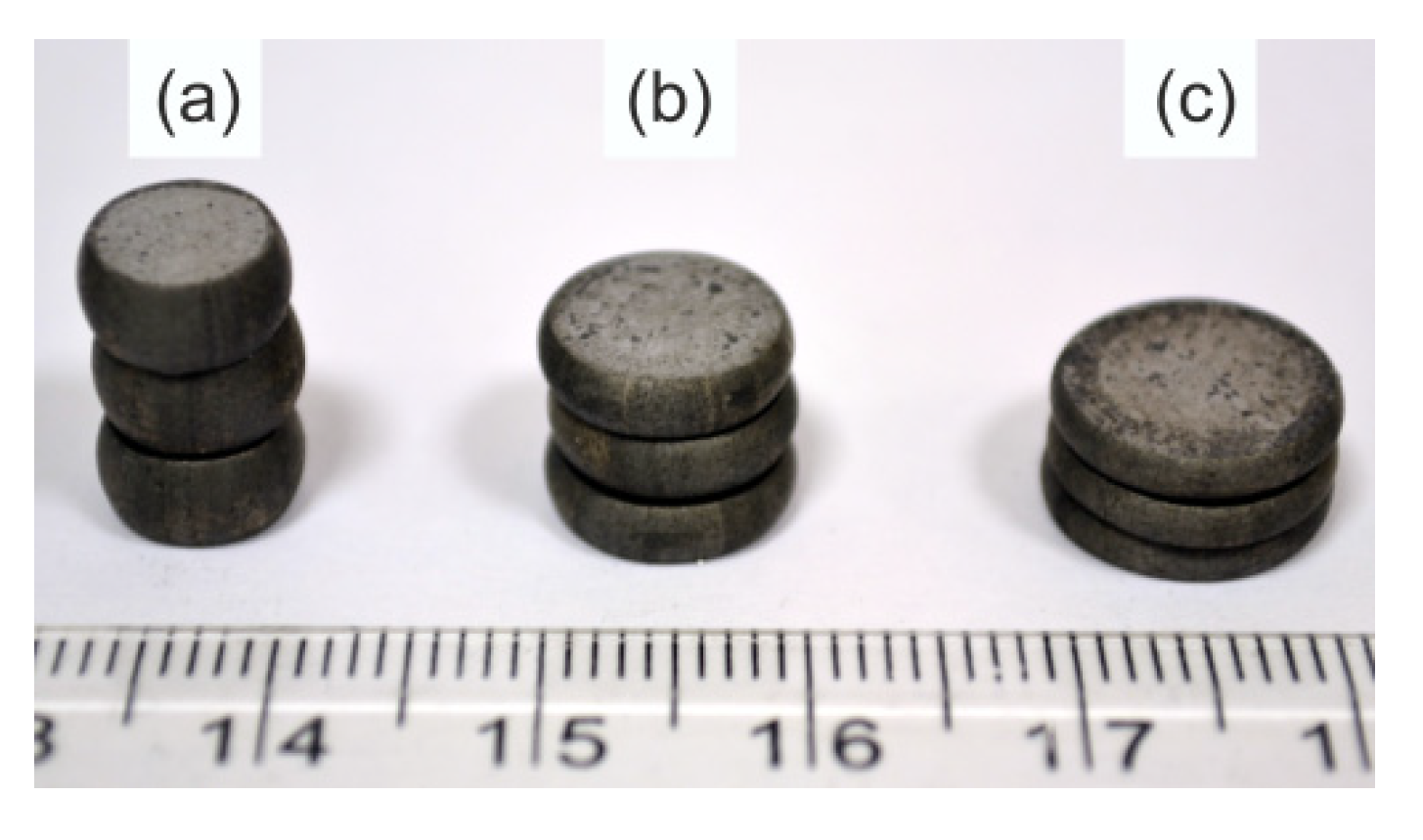
| Steel Grade | Steel Number | Melt Analysis, mass% | ||||||
|---|---|---|---|---|---|---|---|---|
| 20MnB4 | 1.5525 | C | Si | Mn | Pmax, Smax | Cr | Cumax | B |
| 0.18–0.23 | ≤0.30 | 0.90–1.20 | 0.025 | ≤0.30 | 0.25 | 0.0008–0.005 | ||
| Surface Temperature before RSM Block 850 °C | 1 Cooling Stage 2 | ||
|---|---|---|---|
| Desired Surface Temperature Tsurf, °C | Cooling Rate Cr, °C/s | ||
| Cooling variant in STELMOR® line (Primetals Technologies USA LLC, Alpharetta, GA, USA) | W1-1 | 575 | 0.6 |
| W1-2 | 500 | 1 | |
| W1-3 | 500 | 3 | |
| W1-4 | 500 | 5 | |
| W1-5 | 500 | 10 | |
| W1-6 | 500 | 15 | |
| Temperature | Strip Heat Transfer Coefficients From: | Friction Factor , | Coefficient of Friction , | ||||
|---|---|---|---|---|---|---|---|
| Air , | Water , | Rolls , | Air , | Rolls , | Water , | ||
| - | - | ||||||
| 20 | 20 | 60 | 100 | 3000–5000 | 6700–16000 | 0.56–0.8 | 0.28–0.4 |
| Thermophysical Properties of Steel | ||
|---|---|---|
| Thermal Conductivity λ, | Density ρ, | Specific Heat , |
| 35.5 | 7850 | 778 |
| A | m1 | m2 | m3 | m4 | m5 | m7 | m8 | m9 |
|---|---|---|---|---|---|---|---|---|
| 707,153 × 107 | 0.0012 | 0.1943 | 0.0424 | −0.0031 | −0.0004 | −0.0721 | 0.00002 | −3.7326 |
| Cooling Rates Cr [°C/s] | Characteristic Temperatures [°C] |
|---|---|
| 100 | Ms = 406, Mf = 248 |
| 80 | Bs = 550, Bf = 460, Ms = 420, Mf =3 70 |
| 50 | Bs = 560, Bf = 450, Ms = 430, Mf = 324 |
| 30 | Fs = 700, Ff = 680, Ps = 630, Pf = Bs = 550, Bf = 485 |
| 15 | Fs = 729, Ff = Ps = 650, Pf = 560 |
| 10 | Fs = 757, Ff = Ps = 670, Pf = 562 |
| 5 | Fs = 743, Ff = Ps = 670, Pf = 618 |
| 1 | Fs = 760, Ff = Ps = 660, Pf = 633 |
| 0.1 | Fs = 790, Ff = Ps = 692, Pf = 632 |
| where: Ps, Pf, Fs, Ff, Bs, Bf, Ms, Mf—start and end temperature of phase transitions, respectively: perlitic, ferritic, bainitic, martensitic | |
| Pass Number | Strain Intensity [-] | Strain Rate Intensity [s−1] | Stress Intensity [MPa] |
|---|---|---|---|
| Continuous rolling mill | |||
| 1 | 0.18 | 0.16 | 74.76 |
| 2 | 0.39 | 0.35 | 96.02 |
| 3 | 0.28 | 0.39 | 92.81 |
| 4 | 0.59 | 0.96 | 109.57 |
| 5 | 0.46 | 1.15 | 103.10 |
| 6 | 0.50 | 2.02 | 115.55 |
| 7 | 0.45 | 2.45 | 117.61 |
| 8 | 0.48 | 4.71 | 123.21 |
| 9 | 0.44 | 5.57 | 130.59 |
| 10 | 0.54 | 10.39 | 138.72 |
| 11 | 0.48 | 12.07 | 134.07 |
| 12 | 0.50 | 20.53 | 142.58 |
| 13 | 0.51 | 24.74 | 143.39 |
| 14 | 0.50 | 46.34 | 152.09 |
| 15 | 0.41 | 47.13 | 148.10 |
| 16 | 0.51 | 79.93 | 154.04 |
| 17 | 0.31 | 70.63 | 139.36 |
| NTM block of wire rod rolling mill | |||
| 18 | 0.32 | 156.02 | 229.99 |
| 19 | 0.51 | 171.25 | 211.09 |
| 20 | 0.56 | 276.33 | 225.24 |
| 21 | 0.54 | 303.93 | 213.58 |
| 22 | 0.56 | 477.46 | 224.07 |
| 23 | 0.53 | 584.28 | 215.56 |
| 24 | 0.62 | 991.51 | 239.33 |
| 25 | 0.57 | 1042.10 | 198.68 |
| 26 | 0.62 | 1753.46 | 232.37 |
| 27 | 0.41 | 1809.67 | 181.90 |
| RSM block of wire rod rolling mill | |||
| 28 | 0.53 | 2368.05 | 399.89 |
| 29 | 0.48 | 2275.43 | 385.39 |
| 30 | 0.13 | 1853.11 | 378.54 |
| 31 | 0.10 | 1680.68 | 374.72 |
| Pass No. | Continuous Rolling Mill | ||||||||||||||||
| 1 | 2 | 3 | 4 | 5 | 6 | 7 | 8 | 9 | 10 | 11 | 12 | 13 | 14 | 15 | 16 | 17 | |
| Dγ [μm] | 215 | 120 | 127 | 88 | 84 | 76 | 84 | 67 | 65 | 62 | 70 | 68 | 73 | 64 | 63 | 63 | 44 |
| Pass No. | NTM Rolling Mill Block | RSM Rolling Mill Block | |||||||||||||||
| 18 | 19 | 20 | 21 | 22 | 23 | 24 | 25 | 26 | 27 | 28 | 29 | 30 | 31 | ||||
| Dγ [μm] | 43 | 17 | 17 | 17 | 18 | 17 | 18 | 19 | 20 | 42 | 21 | 19 | 18 | 18 | |||
| Cooling Variant | Yield Strength YS [MPa] | Ultimate Tensile Strength UTS [MPa] | Unit Elongation A5 [%] | Relative Reduction of Area at Fracture Z [%] | Number of Twists to Break Nt | Number of Bends to Break Nb | Total Angle of Non-Dilatational Strain γ [°] | Total Longitudinal True Strain εl |
|---|---|---|---|---|---|---|---|---|
| W1-4 | 386 | 525 | 33.1 | 69.4 | 38.1 | 26.2 | 67.3 | 0.95 |
| W1-5 | 415 | 559 | 29.8 | 69.7 | 41.3 | 29.6 | 68.9 | 1.02 |
© 2020 by the authors. Licensee MDPI, Basel, Switzerland. This article is an open access article distributed under the terms and conditions of the Creative Commons Attribution (CC BY) license (http://creativecommons.org/licenses/by/4.0/).
Share and Cite
Laber, K.; Knapiński, M. Determining Conditions for Thermoplastic Processing Guaranteeing Receipt of High-Quality Wire Rod for Cold Upsetting Using Numerical and Physical Modelling Methods. Materials 2020, 13, 711. https://doi.org/10.3390/ma13030711
Laber K, Knapiński M. Determining Conditions for Thermoplastic Processing Guaranteeing Receipt of High-Quality Wire Rod for Cold Upsetting Using Numerical and Physical Modelling Methods. Materials. 2020; 13(3):711. https://doi.org/10.3390/ma13030711
Chicago/Turabian StyleLaber, Konrad, and Marcin Knapiński. 2020. "Determining Conditions for Thermoplastic Processing Guaranteeing Receipt of High-Quality Wire Rod for Cold Upsetting Using Numerical and Physical Modelling Methods" Materials 13, no. 3: 711. https://doi.org/10.3390/ma13030711
APA StyleLaber, K., & Knapiński, M. (2020). Determining Conditions for Thermoplastic Processing Guaranteeing Receipt of High-Quality Wire Rod for Cold Upsetting Using Numerical and Physical Modelling Methods. Materials, 13(3), 711. https://doi.org/10.3390/ma13030711





